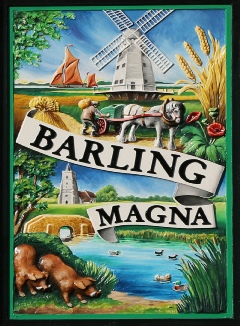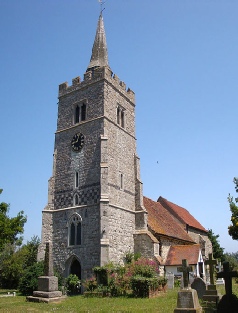




This is the old and battered village sign featuring two Red Boars’ Heads
Copyright © Barling Magna Parish Council
Web Design -
Barling History by Val Smith
People have lived in the area since the Palaeolithic Age. From the Mesolithic Age, people were attracted here by the fertile soils of the brick earth. The Romans were also in evidence in the area but it is the Saxons who gave the names of Barling and Little Wakering to the villages. Barling is now generally accepted to mean ‘Baerla’s people’ and Little Wakering from the ‘People of Wacor or Waecer’.
In 998, Leofwine, a Saxon Theyn, left Barling in his will, to Bishop Wulfstan and it became part of the lands owned by St Paul’s in London who already owned land in neighbouring Shopland.
When the Domesday Book was compiled in 1085, the manor of Little Wakering was part of the lands of Swein, Barling was part of the Lands of the Canons of St Paul’s, Richard, son of Gilbert held Barrow Hall and Bishop Odo, brother to William the Conqueror held Mucking Hall.
There are two ancient churches in the villages. During the 1100’s, construction of both churches is believed to have started, the nave and chancel at St Mary’s are Norman and there is proof that they were built before 1190 when the Advowson and land of St Mary’s, Little Wakering was deeded by William de Tayden to St Bartholomew’s Hospital, London. The Tower at St Mary’s is said to have been built by John Wakering, Bishop of Norwich of Barrow Hall, with financial assistance from Anne, Countess of Stafford as a thanks offering for his safe return from Agincourt in 1416.
The south wall of the nave in All Saints’, Barling Magna is believed to be the oldest dating from the 12th century with additions through to the 15th Century. The Victorians undertook a major renovation in the mid 1800’s.
Both churches once had their own Vicarages. The present Little Wakering Vicarage, adjacent to the church was built in 1866 and was sold in 2006. The Glebe in Barling, dating from the 1700’s has been in private hands for a considerable time.
Barling had at one time a windmill. In 1181, a mill is recorded to have existed there. On maps dating from 1724 and 1749, a mill symbol is shown, close to the church in Church Road, however, the Smock Mill built around 1760 stood on the site until it was demolished in 1946. It had four storeys, a circular brick base and was weather boarded. Above all this was the wooden cap, at the rear of which was a circular wheel around which ran an endless chain enabling the cap to be turned. The four large sails almost touched the ground when in motion. A new domestic dwelling is currently being constructed on the old mill site.
During the time of the Peasants Revolt in 1381, Court Rolls were burnt at the Manor of Little Wakering Hall.
During the time of Elizabeth I, Barling was a busy sea trading port and in the returns of 1564, Barling reported 23 ships with 48 marines and fisherman. In the 1580’s Little Wakering built 6 vessels under a bounty scheme. Both ports traded with London and the Low Countries, the main cargoes being grain, oysters, timber and wool.
The area has always and still is agricultural. In the past there were numerous farms and homesteads, these have now been amalgamated into three or four large farms. The area is bordered by marshland and creeks. Winter wading birds frequent the area and there is a rich assortment of wildlife.
There are many listed properties in the area, the earliest dating from the late 1400’s. The first Board School to be built in Barling in 1877 is situated along Little Wakering Road and is now in use as a Day Nursery. The privately owned Weir Pond at the start of Church Road is of old origin, once used as a watering place for cattle, and now home to a resident flock of wild mallard and moor hens.



